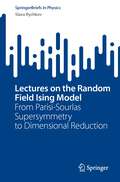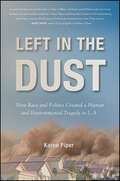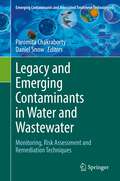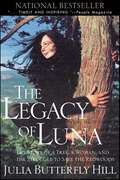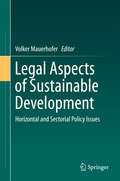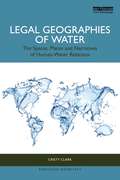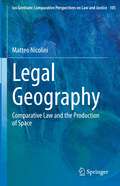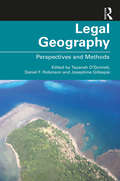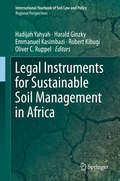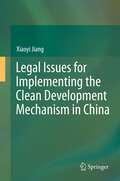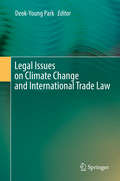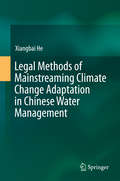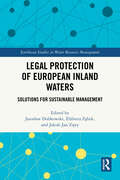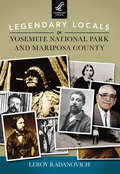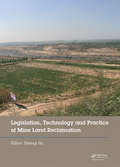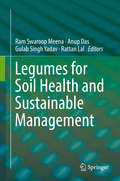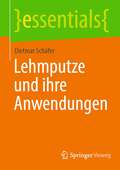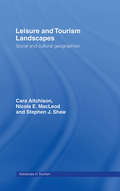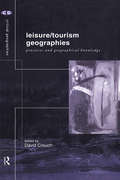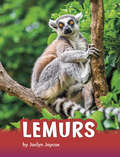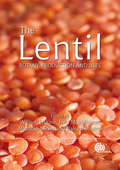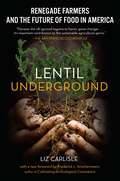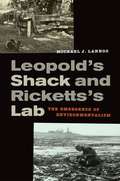- Table View
- List View
Lectures on the Random Field Ising Model: From Parisi-Sourlas Supersymmetry to Dimensional Reduction (SpringerBriefs in Physics)
by Slava RychkovThis book is about the Random Field Ising Model (RFIM) – a paradigmatic spin model featuring a frozen disordering field. The focus is on the second-order phase transition between the paramagnetic and ferromagnetic phases, and the associated critical exponents. The book starts by summarizing the current knowledge about the RFIM from experiments, numerical simulations and rigorous mathematical results. It then reviews the classic theoretical works from the 1970’s which suggested a property of dimensional reduction – that the RFIM critical exponents should be the same as for the ordinary, non-disordered, Ising model of lower dimensionality, and related this an emergent Parisi-Sourlas supersymmetry. As is now known, these remarkable properties only hold when the spatial dimensionality of the model is larger than a critical dimension. The book presents a method to estimate the critical dimension, using standard tools such as the replica trick and perturbative renormalization group, whose result is in agreement with the numerical simulations. Some more elementary steps in the derivations are left as exercises for the readers. This book is of interest to researchers, PhD students and advanced master students specializing in statistical field theory.
Ledger: Poems
by Jane HirshfieldA pivotal book of personal, ecological, and political reckoning from the internationally renowned poet named "among the modern masters" (The Washington Post).Ledger's pages hold the most important and masterly work yet by Jane Hirshfield, one of our most celebrated contemporary poets. From the already much-quoted opening lines of despair and defiance ("Let them not say: we did not see it. / We saw"), Hirshfield's poems inscribe a registry, both personal and communal, of our present-day predicaments. They call us to deepened dimensions of thought, feeling, and action. They summon our responsibility to sustain one another and the earth while pondering, acutely and tenderly, the crises of refugees, justice, and climate. They consider "the minimum mass for a whale, for a language, an ice cap," recognize the intimacies of connection, and meditate upon doubt and contentment, a library book with previously dog-eared corners, the hunger for surprise, and the debt we owe this world's continuing beauty. Hirshfield's signature alloy of fact and imagination, clarity and mystery, inquiry, observation, and embodied emotion has created a book of indispensable poems, tuned toward issues of consequence to all who share this world's current and future fate.
Left in the Dust: How Race and Politics Created a Human and Environmental Tragedy in L.A.
by Karen PiperAn intensely personal story crossed with a political potboiler, Left in the Dust is a unique and passionate account of the city of Los Angeles's creation, cover-up and inadequate attempts to repair a major environmental catastrophe. Owens River, which once fed Owens Lake, was diverted away from the lake to supply the faucets and sprinklers of Los Angeles. The dry lakebed now contains a dust saturated with toxic heavy metals, which are blown from the lake and inhaled by unsuspecting citizens throughout the Midwest, causing major health issues. Karen Piper, one of the victims who grew up breathing that dust, reveals the shocking truth behind this tragedy and examines how waste and pollution are often neglected to encourage urban growth, while poor, non-white, and rural areas are forgotten or sacrificed.
Legacy and Emerging Contaminants in Water and Wastewater: Monitoring, Risk Assessment and Remediation Techniques (Emerging Contaminants and Associated Treatment Technologies)
by Daniel Snow Paromita ChakrabortyThis volume provides a collection of research findings on the distribution and risk associated with emerging contaminants (ECs) in water and wastewater across the globe, and effective remediation techniques and technologies. The book covers various monitoring techniques for ECs in water and wastewater and its related impacts on the ambient environment, and offers valuable information on cost-effective monitoring techniques and sustainable treatment technologies for ECs. The authors detail the risks and biological effects of ECs and legacy persistent organic pollutants (POPs) in freshwater and marine systems, including their adverse interactions with aquatic organisms, while also discussing the associated impacts on human health. The book comprehensively covers current research outcomes on treatment methods, cost-effectiveness, and infrastructure needs for effective removal of ECs. It will be of interest to students, researchers, and scholars in environmental science and engineering, water and wastewater, toxicology, environmental biotechnology, soil sciences, and microbial ecology.
Legacy of Luna: The Story of a Tree, a Woman, and the Struggle to Save the Redwoods
by Julia Butterfly HillOn December 18, 1999, Julia Butterfly Hill's feet touched the ground for the first time in over two years, as she descended from "Luna," a thousandyear-old redwood in Humboldt County, California.Hill had climbed 180 feet up into the tree high on a mountain on December 10, 1997, for what she thought would be a two- to three-week-long "tree-sit." The action was intended to stop Pacific Lumber, a division of the Maxxam Corporation, from the environmentally destructive process of clear-cutting the ancient redwood and the trees around it. The area immediately next to Luna had already been stripped and, because, as many believed, nothing was left to hold the soil to the mountain, a huge part of the hill had slid into the town of Stafford, wiping out many homes.Over the course of what turned into an historic civil action, Hill endured El Nino storms, helicopter harassment, a ten-day siege by company security guards, and the tremendous sorrow brought about by an old-growth forest's destruction. This story--written while she lived on a tiny platform eighteen stories off the ground--is one that only she can tell.Twenty-five-year-old Julia Butterfly Hill never planned to become what some have called her--the Rosa Parks of the environmental movement. Shenever expected to be honored as one of Good Housekeeping's "Most Admired Women of 1998" and George magazine's "20 Most Interesting Women in Politics," to be featured in People magazine's "25 Most Intriguing People of the Year" issue, or to receive hundreds of letters weekly from young people around the world. Indeed, when she first climbed into Luna, she had no way of knowing the harrowing weather conditions and the attacks on her and her cause. She had no idea of the loneliness she would face or that her feet wouldn't touch ground for more than two years. She couldn't predict the pain of being an eyewitness to the attempted destruction of one of the last ancient redwood forests in the world, nor could she anticipate the immeasurable strength she would gain or the life lessons she would learn from Luna. Although her brave vigil and indomitable spirit have made her a heroine in the eyes of many, Julia's story is a simple, heartening tale of love, conviction, and the profound courage she has summoned to fight for our earth's legacy.
Legal Aspects of Sustainable Development
by Volker MauerhoferThis book addresses legal aspects of sustainable development and offers the latest thinking on a wide range of current themes. By taking a cross-cutting approach, it adds considerably to the exploration of this emerging scientific field. Twenty-nine original contributions present innovative thoughts and replicable ideas from this exciting, new area, which will be of value to practitioners and researchers alike. These contributions are allocated into a horizontal and sectorial part. The section covering horizontal policies has five sub-parts: 1) general aspects; 2) human and intellectual property rights; 3) communication and social enterprise governance; 4) public participation and 5) assessment tools. The second part on sectorial policies also has five sub-parts: 1) forest and water management; 2) renewable energy; 3) cities, waste and material management; 4) biodiversity, nature conservation, oceans and spatial planning and 5) agriculture and rural policy. It offers a multifaceted discussion of sustainable development and law by authors from five continents and from both the public and the private sectors. This selection guarantees a broad view that presents the more theoretical arguments from the academic as well as the practical perspective. Furthermore, the authorship includes senior, highly experienced academics and practitioners as well as those at the start of their career. This ensures thoughtful expansions of established theories as well as the emergence of innovative ideas. Moreover, the ten sub-parts bring together likeminded thoughts, resulting in an exchange of different viewpoints on a similar theme. This allows the readers to concentrate on individual chapters, while at the same time discovering a variety of thoughts and ideas.
Legal Geographies of Water: The Spaces, Places and Narratives of Human-Water Relations (Earthscan Water Text)
by Cristy ClarkThis book deepens our understanding of humanity’s diverse relationships with water and the law, providing a critical assessment of this relationship, and charting the course towards a more sustainable and just water future.By using legal geography, this book pays particular attention to the place-based inter-relationships between water, people, and law (both formal and informal) and to the ways that law both constitutes and is constituted by the relationship between people and place. Starting in the 1980s, Chapter 2 investigates the early commodification of water through the liberalisation of rural water markets in Chile and the urban water supply and sanitation systems of England and Wales. Chapter 3 then examines the global expansion of neoliberal water governance in the 1990s, starting with donor-driven reforms in the global south and particularly Manila in the Philippines. Chapters 4 and 5 document both the grassroots response to these neoliberal water reforms and the inherent tensions in the attempts of the early 2000s to reconcile the recognition of a human right to water with the ongoing rollout of market mechanisms, both in the domestic context of South Africa and within the United Nations human rights system. Moving forward again, Chapter 6 examines the recent intensification of neoliberal water governance through financialisation and considers its specific impacts in Detroit and Flint, Michigan. Chapter 7 then considers the renewed global emphasis on living waters and Indigenous ontologies of water by examining the new legislative arrangements for the Whanganui River in Aotearoa, New Zealand. The book concludes in Chapter 8 by highlighting the stories of hope that can be found in many of the case studies explored in the book and in emerging examples from around the world.This book is essential reading for students and scholars interested in water law, security, and justice from across a wide range of disciplines, including environmental studies, law, geography, human rights, and political ecology.
Legal Geography: Comparative Law and the Production of Space (Ius Gentium: Comparative Perspectives on Law and Justice #105)
by Matteo NicoliniThis book invites readers to critically rethink the interrelations between geography and the law. Traditionally, legal-geographical interrelations have been dominated by scholars with backgrounds in geopolitics, economics, or geography. More recently, a new interdisciplinary approach has been developed with the aim of offering a fresh perspective on how law and geography intersect. There has been a steady growth in cross-disciplinary research in this field; how legal-geographical taxonomies interrelate has attracted attention from scholars and academics with a diverse range of backgrounds – namely, law, anthropology, and human/physical geography –, thus giving rise to several publications.Against this backdrop, the book adopts a legal comparative perspective and assesses ‘normative spatialities’, which are the outcomes of processes of legal-spatial production. In addition, the comparative analysis offers readers new insights on some traditional geographic features which are essential to legal studies (territorial identity, regional demarcation, territorial alternation, and place-name policy). Examples are drawn from several jurisdictions (both from the Global North and the Global South) and partly employ a diachronic perspective.As its subversive character is ideally suited to revealing policies and agendas, comparative law is used to identify the ethnocentric and colonial biases underpinning the use (and misuse) of legal geographic devices by policymakers and academics. In sum, the book presents legal geography as an interdisciplinary undertaking in which geographers and legal scholars can jointly examine common concepts in the historical, cultural, political and social contexts in which law is practised. The book transcends the boundaries between disciplines to engage in a fruitful dialogue on how the law can help to address the current socio-geographic and ecological crises.
Legal Geography: Perspectives and Methods
by Daniel F. Robinson Edited by Tayanah O’Donnell Josephine GillespieThis book is the first legal geography book to explicitly engage in method. It complements this by also bringing together different perspectives on the emerging school of legal geography. It explores human–environment interactions and showcases distinct environmental legal geography scholarship. Legal Geography: Perspectives and Methods is an innovative book concerned with a new relational and material way of examining our legal-spatial world. With chapters examining natural resource management, Indigenous knowledge and political ecology scholarship, the text introduces legal geography’s modes of analysis and critique. The book explores topics such as Indigenous environmental rights, the impacts of extractive industries, mediation of climate change, food, animal and plant patents, fossil fuels, mining and coastal environments based on empirical, jurisdictional and methodological insights from Australia, New Zealand and the Asia-Pacific to demonstrate how space and place are invoked in legal processes and contestations, and the methods that may be employed to explore these processes and contestations. This book examines the role of legal geographies in the 21st century beyond the simple “law in action”, and it will thus appeal to students of socio-legal studies, human geography, environmental studies, environmental policy, as well as politics and international relations.
Legal Instruments for Sustainable Soil Management in Africa (International Yearbook of Soil Law and Policy)
by Harald Ginzky Oliver C. Ruppel Emmanuel Kasimbazi Hadijah Yahyah Robert KibugiThis book presents an important discussion on future options for sustainable soil management in Africa from various perspectives, including national soil protection regulations, the role of tenure rights, the work of relevant international institutions such as the UNCCD and FAO, and regional and international cooperation. This first volume of the new subseries Regional Perspectives to the International Yearbook of Soil Law and Policy includes contributions by African and international experts alike. Given the range of key topics covered, the book offers an indispensable tool for all academics, legislators and policymakers working in this field. The “International Yearbook of Soil Law and Policy – Regional Perspectives” series discusses central questions in law and politics that concern the protection and sustainable management of soil and land in different regions of the world.
Legal Issues for Implementing the Clean Development Mechanism in China
by Xiaoyi JiangToday, climate change is among the most hotly-debated topics. The Clean Development Mechanism (CDM), one of the three financial mechanisms under the Kyoto Protocol open to developing and developed countries, was devised to assist in mitigation of global warming. This book discusses what China should do to make full use of the CDM to promote sustainable development and to meet the challenge of climate change from a legal perspective. The findings lead to the conclusion that the CDM has limitations in promoting sustainable development in China, and thus should be regarded only as a complementary instrument in combating climate change. Legal strategies for improving the implementation of CDM projects under the legal framework in China are thus put forward, and some proposals for China to meet the challenge of climate change in the post-2012 era are made. This book offers new insights to academics and policymakers both in the public and private sector. It is intended for legal practitioners and researchers on carbon trading as well as policymakers interested in the role of developing countries in climate change law. In addition, it is of interest to stakeholders of CDM projects.
Legal Issues on Climate Change and International Trade Law
by Deok-Young ParkThis book provides anexcellent overview of the legal issues surrounding climate change mitigationand international trade law. It surveys key observed and potential challengesposed by responses to climate change in terms of international trade law. By examiningthe controversial issues seen in legal cases in which domestic climate changeor renewable energy measures conflicted with international trade regimes, thisvolume promotes and broadens the understanding and debate of the issues. Beyondthe recognized challenges, this book uncovers potential areas of conflictbetween climate change responses and international trade promotion by exploringprevious cases and current efforts to prevent climate change. Furthermore, thisvolume sheds light on the future direction of international trade law andclimate change responses, pointing out that the development of climate changeor renewable energy laws and policies must also consider international traderegimes in order to ensure the smooth implementation of said laws and policiesand guarantee that international trade laws do not restrict environmentalpolicy space.
Legal Methods of Mainstreaming Climate Change Adaptation in Chinese Water Management
by Xiangbai HeThis book addresses why, whether and how the existing legal framework on water management in China could make climate change adaptation a mainstream issue. The book uses a table to illustrate the distinctions and similarities between IWRM and water-centered adaptation to analyze the possibilities of mainstreaming adaptation. The new water-planning processes and EIA are also illustrated in the form of figures showing the differences after factoring in adaptation considerations. Interviews with water managers to obtain their perception and attitudes towards climate change adaptation offer new perspectives for readers. The adaptation- mainstreaming approach, which finds a way to balance various interests and tasks, will arouse the interests of those readers who argue that climate change is only one of the issues challenging water management, and that poverty reduction, environmental protection and living standard improvement are even more important. Readers will also be interested to discover that the adaptation mainstreaming approach could be applied in water management institutions such as water planning and EIA. In addition, the book offers a clear explanation of the challenges of adaptation to the existing water-related legal framework from a theoretical perspective, and provides theoretical and practical recommendations.
Legal Protection of European Inland Waters: Solutions for Sustainable Management (Earthscan Studies in Water Resource Management)
by Jarosław Dobkowski Elżbieta Zębek Jakub Jan ZiętyThis book examines the legal protection and management of inland waters in Europe.With inland waters facing a range of significant threats, including from climate change, pollution, and overexploitation, this volume discusses legal solutions for protecting and managing these inland waters. It presents comparative studies from a range of European countries, including the Czech Republic, Germany, France, Lithuania, Poland, and Spain, with each chapter examining the legal status and legal instruments being implemented in each country, allowing for easy cross-comparison. Topics covered include surface water management and protection, water quality and monitoring, management of hazardous substances, and crisis management. Through these unique comparative studies, the volume highlights legal solutions which can be adopted by other nations and used as models for wider implementation across Europe. In doing so, this book offers important recommendations for changing water law to ensure a water secure future in Europe.This book will be of great interest to students and scholars of water law, water resource management, environmental policy, and environmental conservation.
Legendary Locals of Yosemite National Park and Mariposa County (Legendary Locals)
by Leroy RadanovichIn 1846, Thomas Larkin, American council general to the Mexican government in California, purchased a Mexican land grant, Las Mariposas, for Col. John C. Fremont. The grant consisted of 10 square leagues of grazing land located near the Merced River and west of the Sierra. In 1848, when California became the possession of the United States, the treaty called for the recognition of preexisting grants. Gold was discovered in the foothills of the Sierra that same year. Fremont floated his questionable Mexican grant into the gold discovery region. With the formation of the State of California in 1850, one of the original counties was named Mariposa, Spanish for "butterflies." Located within the county was the Fremont grant and much of the yet undiscovered Yosemite region of the Sierra. Encounters with Native Americans near the mining camps lead to the formation of the Mariposa Battalion, and a search for the natives led to the American discovery of Yosemite Valley. Thus, it was custodians and photographers such as Charles Leander Weed, Carlton E Watkins, J.J. Riley, George Fiske, Ansel Adams, and many others that interpreted and introduced Yosemite to the world.
Legislation, Technology and Practice of Mine Land Reclamation: Proceedings of the Beijing International Symposium on Land Reclamation and Ecological Restoration (LRER 2014), Beijing, China, 16-19 October 2014
by Zhenqi HuLegislation, Technology and Practice of Mine Land Reclamation contains the proceedings of the Beijing International Symposium on Land Reclamation and Ecological Restoration (LRER 2014, Beijing, China, 16-19 October 2014).The contributions cover a wide range of topics:- Monitoring, prediction and assessment of environmental damage in mining areas- S
Legumes for Soil Health and Sustainable Management
by Rattan Lal Ram Swaroop Meena Anup Das Gulab Singh YadavSustainable management of soils is an important global issue of the 21st century. Feeding roughly 8 billion people with an environmentally sustainable production system is a major challenge, especially considering the fact that 10% of the world’s population at risk of hunger and 25% at risk of malnutrition. Accordingly, the 68th United Nations (UN) general assembly declared 2016 the “International Year of Pulses” to raise awareness and to celebrate the role of pulses in human nutrition and welfare. Likewise, the assembly declared the year 2015 as the “International Year of Soils” to promote awareness of the role of “healthy soils for a healthy life” and the International Union of Soil Science (IUSS) has declared 2015-2024 as the International Decade of Soils. Including legumes in cropping systems is an important toward advancing soil sustainability, food and nutritional security without compromising soil quality or its production potential. Several textbooks and edited volumes are currently available on general soil fertility or on legumes but‚ to date‚ none have been dedicated to the study of “Legumes for Soil Health and Sustainable Management”. This is important aspect, as the soil, the epidermis of the Earth (geoderma)‚ is the major component of the terrestrial biosphere. This book explores the impacts of legumes on soil health and sustainability, structure and functioning of agro-ecosystems, agronomic productivity and food security, BNF, microbial transformation of soil N and P, plant-growth-promoting rhizobacteria, biofertilizers, etc. With the advent of fertilizers, legumes have been sidelined since World War II, which has produced serious consequences for soils and the environment alike. Therefore, legume-based rational cropping/soil management practices must support environmentally and economically sustainable agroecosystems based on (sequential) rotation and intercropping considerations to restore soil health and sustainability. All chapters are amply illustrated with appropriately placed data, tables, figures, and photographs, and supported with extensive and cutting-edge references. The editors have provided a roadmap for the sustainable development of legumes for food and nutritional security and soil sustainability in agricultural systems, offering a unique resource for teachers, researchers, and policymakers, as well as undergraduate and graduate students of soil science, agronomy, ecology, and the environmental sciences.
Lehmputze und ihre Anwendungen (essentials)
by Dietmar SchäferDas Buch beschäftigt sich mit dem Lehmputz und der Technologie des Lehmputzes in Europa. Es werden Gemeinsamkeiten und Unterschiede der jeweiligen Lehmputztechnologien aufgezeigt.
Lehrbuch zur Experimentalphysik Band 1: Mechanik
by Joachim HeintzeDieses Buch zur Experimentalphysik ist der erste Band der lange erwarteten Ausarbeitung der überaus beliebten Vorlesungen von Joachim Heintze. Die Liebe des Autors für die Physik und für spannende und historische Experimente ist in das Buch eingegangen und in allen Kapiteln unvermindert zu spüren.Hier finden Sie alle für das Bachelor- und das Nebenfachstudium der Physik relevanten Themen in anschaulicher und besonders gut verständlicher Form mit vielen Abbildungen präsentiert. Übungsaufgaben mit ausführlichen Lösungen erleichtern die Prüfungsvorbereitung. Ob Physik Ihr Hauptfach sein mag oder ein Begleitfach − in jedem Fall werden Sie von den klaren Erläuterungen und den eingängigen Darstellungen profitieren und vieles mitnehmen, das Sie auf Ihrem weiteren Weg begleiten wird."Möge dieses Buch dazu dienen, allen Studenten die Schönheit der Physik aufzuzeigen, Zusammenhänge zu sehen, das Studium zu erleichtern und damit dieses Vermächtnis zu erkennen und weiter zu tragen."Hans-Georg Siebig, Aus dem VorwortDer AutorJoachim Heintze studierte Physik in Berlin und an der Universität Göttingen und wurde 1953 an der Universität Heidelberg bei Otto Haxel promoviert. 1958 habilitierte er über Elektronenspinpolarisation beim Betazerfall. Danach war er einige Jahre am CERN. 1963 erhielt er mit Volker Soergel für Arbeiten zur Messung des seltenen Betazerfall des Pions den Gustav-Hertz-Preis. Ab 1964 war Heintze Professor an der Universität Heidelberg.
Leisure and Tourism Landscapes: Social and Cultural Geographies (Routledge Advances in Tourism #No.9)
by Cara Aitchison Nicola E. MacLeod Nicola E Macleod Stephen J. ShawIncreasingly significant as mediators of spatial identity and meaning, leisure, tourism, culture and heritage are only now beginning to be located within the rapidly evolving discourses of poststructuralist geographies. Exploring the influence of leisure and tourism on the production, representation and consumption of landscape, the first half of this important book focuses on different ways of ‘seeing’ or representing landscape, whereas the second half examines different forms of productive consumption in leisure and tourism. Both symbolic and material spaces of leisure and tourism are also examined in relation to urban and rural landscapes, heritage landscapes, gendered landscapes, and landscapes of sexuality and desire. With a multidisciplinary approach and a strong theoretical content which builds on poststructuralist theories, this is undoubtedly an important addition to literature in the field.
Leisure/Tourism Geographies: Practices and Geographical Knowledge (Critical Geographies #Vol. 3)
by David CrouchLeisure and Tourism Geographies considers leisure/tourism as an encounter. An encounter that exists between people, between people and space and between people and their expectations, experiences and desires.The contributors explore diverse aspects of leisure and tourism, ranging from the methodologies behind leisure practices to detailed case studies including: *Disneyland, Paris*tourism in sacred landscapes*leisure practices in cyberspace*leisure and yachting*use of recreational/holiday cottages*National Parks, local parks and gardensPresenting an exciting mix of attitudes and ideas concerning leisure and tourism, this book documents a lively debate, placing geography at its centre.
Lemurs (Animals)
by Jaclyn JaycoxLemurs are small, furry mammals with big eyes and long tails. Like humans, they are primates. These adorable animals settle their arguments with stink fights! Find out more about these curious creatures.
Lentil
by William Erskine Fred Muehlbauer Ashutosh Sarker Balram SharmaIn the last three decades, the global production of lentils has almost tripled due to larger harvest areas but also more importantly from progress in research and productivity. Chapters outline improvements in production, such as water and soil nutrient management, agronomy, mechanization and weed management. Developments in genetics and breeding are discussed alongside improved knowledge of the lentil's origin, domestication, morphology and adaptation. The implementation and impact of this new research at the farm level is also addressed as well as the crop's post-harvest processing and nutritional value.
Lentil Underground: Renegade Farmers and the Future of Food in America
by Liz CarlisleA protégé of Michael Pollan shares the story of a little known group of renegade farmers who defied corporate agribusiness by launching a unique sustainable farm-to-table food movement.<P><P> The story of the Lentil Underground begins on a 280-acre homestead rooted in America's Great Plains: the Oien family farm. Forty years ago, corporate agribusiness told small farmers like the Oiens to "get big or get out." But twenty-seven-year-old David Oien decided to take a stand, becoming the first in his conservative Montana county to plant a radically different crop: organic lentils. <P> Unlike the chemically dependent grains American farmers had been told to grow, lentils make their own fertilizer and tolerate variable climate conditions, so their farmers aren't beholden to industrial methods. Today, Oien leads an underground network of organic farmers who work with heirloom seeds and biologically diverse farm systems. Under the brand Timeless Natural Food, their unique business-cum-movement has grown into a million dollar enterprise that sells to Whole Foods, hundreds of independent natural foods stores, and a host of renowned restaurants.<P> From the heart of Big Sky Country comes this inspiring story of a handful of colorful pioneers who have successfully bucked the chemically-based food chain and the entrenched power of agribusiness's one percent, by stubbornly banding together. Journalist and native Montanan Liz Carlisle weaves an eye-opening and richly reported narrative that will be welcomed by everyone concerned with the future of American agriculture and natural food in an increasingly uncertain world.
Leopold’s Shack and Ricketts’s Lab: The Emergence of Environmentalism
by Michael J. LannooAldo Leopold and Ed Ricketts are giants in the history of environmental awareness. This illuminating book reveals the full extent of their profound and parallel influence both on science and our perception of natural world today.
